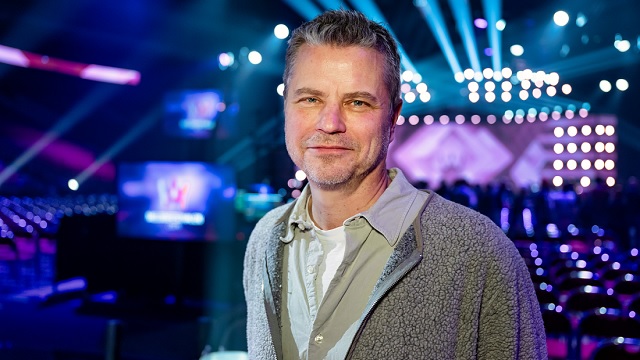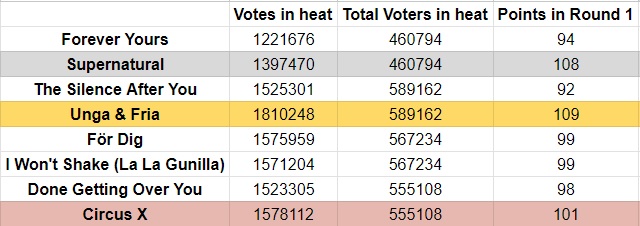01Usually at this point in the Melodifestivalen merry-go-round we reach the round that has been known as Andra Chansen or as the Semi Final, a show dedicated to songs that have just missed out on going to Friends Arena directly that get a second bite of the cherry.
That concept is no more. Instead, this penultimate part of the programming includes new music, with the final six competing acts competing to advance to the final in the same show format we have had in the past four weeks.
However, this fifth show will be extended by 30 minutes. This 30 minute extension to the show is called The Final Qualifiers (‘Finalkval’ in Swedish), and in this show the ten songs that finished 3rd and 4th in their heats will battle out for the two remaining positions in the Melodifestivalen final which will once again be made up of 12 songs.
There is reasoning behind this change of program structure. The Project Manager for Melodifestivalen Anders Wistbacka notes that, whether it was the Semi Final or Andra Chansen, this 5th episode of 6 “did not deliver as we expected.” He notes that not only is the viewership down, but also there is significantly less engagement on social media and less interest from journalists to cover this week. Not having any new artists or songs was a significant factor that the team realised made this show less appealing.

Anders Wistbacka (Photo: SVT)
How Do The Final Qualifiers Work?
After an “as normal” heat five the 30 minute Final Qualifiers section begins. This extension of the show starts off with us seeing the current standings of the ten songs in contention for those two spots.
A somewhat complex formula calculates the current standings, so read this carefully. The current standings at the start of the Final Qualifiers show are determined by the number of votes each song got in their heat, divided by the number of voters in that heat. This gives each act a certain score, and the higher that score, the higher the number of points awarded is. There are 1000 points in total in this round that will be distributed amongst the ten acts.
At this point we then cut to the green room for a painfully long interview sequence with host Carina Berg speaking to each of the ten acts (at least at today’s dress rehearsal), before a recap of each song is played.
This recap goes in heat order, with the two songs that competed in the first heat getting forty seconds of airtime to get votes first, ending with the two songs that competed in heat five.
Voting lines will open via the Melodifestivalen app and televoting during this time. Viewers can vote for the songs they want to see in advance of the Melodifestivalen final, and these votes will decide the final 1000 points on offer. There is less mathematics in this round, with these final 1000 points being distributed depending on the percentage of votes received in the second voting window.
The top two advance to the final in Friends Arena. Suppose there is a tie-break situation (which is arguably more likely than at Eurovision due to the narrow points distribution). In that case, the song with the most points in the voting during the Final Qualifiers round is victorious.
While the mathematics underneath the points distributions may be more difficult to understand than voting often is, this presentation will be familiar to anybody who knows the Eurovision Song Contest. Half of the votes have been determined before this broadcast segment, and half the viewers will decide now. The presentation of the final results will follow the same pattern we see at Eurovision and even the Melodifestivalen final, starting with the act that received the lowest number of points in the first half of the voting.
The only difference to Eurovision is that we have two winners of the Final Qualifiers Round, and yes, both will be given their moment to have a qualifying reprise in the show. Once the first qualifying song is mathematically known, they can perform to the audience just like all the other ten qualifiers.
We then return to the green room for the final split-screen to decide who gets the twelfth and last spot in the Melodifestivalen final. That last act ends the show by performing their song.
How Would This Have Changed Last Year’s Result
We can show how this works by looking at the Semi Final stage of last year’s Melodifestivalen as an approximation for how this model would work. Now it isn’t exactly the same concept as of course the 2023 Semi Final round of Melodifestivalen was a separate show with different performances (well, the biggest difference was an extra splash of pyro here and there, so not so much).
For the eight songs that qualified for the Semi Final round last year, we calculated their score using the 2024 Final Qualifiers Round system. The first round points are determined by that song’s votes in their heat divided by the number of voters in their heat, with a total score for all eight songs of 800 (keeping the 100 points/song ratio). The second round points we have calculated from the number of votes each song received in the Semi Final show itself.

Projections for the qualifiers for the 2023 Melodifestivalen should the 2024 Final Qualifers formula be used
These results show a significant difference from the results that actually occurred in last year’s Semi Final. Four songs progressed from last year’s Semi Final but with this combination one of the eventual qualifiers missed the mark, with Mariette’s ‘One Day’ finishing a lowly 6th place, 11 points behind the entry from Tennessee Tears that would have taken the final qualification spot.
It’s arguably even more topsy-turvy if we look at just the top two as this week’s Final Qualifiers Round will do. This new format sees Theoz and Kiana take the top two slots, with Nordman finishing in 3rd place. This is remarkable as it was Nordman who infact comfortably won the Semi Final last year, scoring 75 points out of a possible 96 to finish five points above Theoz and six points above Kiana.
Why would there be such a difference? One aspect could well be how the first-round points are calculated, with the division of points dependent on the number of voters. Both Nordman and Mariette were drawn in the same heats as last year’s top two from Marcus & Martinus and Loreen, which drove down their score in this first heat a few points. Furthermore, notably, both Mariette and Nordman saw significant appeal from voters in the older age categories, whereas Kiana and Theoz, in particular, swept the votes from Melodifestivalen’s younger viewers.
Melodifestivalen’s age group voting system means that the viewers aged 16-29 have the same voting strength as the group 60-74. But are these groups actually equal? Thanks to some number crunching from Twitter user dolphin_dane, we looked at the correlation between the number of votes each song received in the 2022 and 2023 editions of Melodifestivalen compared to the number of points given out by each age category. Regression analysis suggests that the 16-29 age group correlates most with the number of votes each song gets, whereas the older age group voters are far smaller in raw voting numbers.
Predicting The Final Qualifiers Round 2024
Now at this point in the Melodifestivalen cycle we do not know the number of votes each song got in each heat, so much information is only revealed after the season is over. However, we do know the number of voters in each heat and the points distribution of songs in each heat for the third and fourth-place songs. Can we use this information to predict how the Final Qualifiers Round will start?
We need to make some assumptions to do this, assuming that the eight qualifiers so far share 800 points (leaving 100 points each to the songs qualifying from heat 5), and we have to assume that none of the heats were any stronger or weaker than any others except for the number of voters in each heat statistic.
For the eight songs already qualified to the Final Qualifiers Round, our table of Round 1 points looks like this.

As you can see, our model projects that Fröken Snusk and ‘Unga & Fria’ are expected to lead after the first half of the points have been awarded. This is heavily weighted by the fact that Fröken Snusk scored 42 out of a possible 48 points from the younger age categories, including a 12 points from the 16-29 category. This may surprise many as Dear Sara and ‘The Silence After You’ scored three points more than Fröken Snusk during the voting reveal in the second heat. Still, the majority of Dear Sara’s points came from the older categories that our model predicts has less voters.
Indeed, we see this as a recurring pattern for all of the four heats so far. The other third placed songs in the heats, ‘Forever Yours’, ‘För Dig’ and ‘Done Getting Over You’ are songs that we project will received less or equal points to the acts in fourth place in those respective heats. This leads to a table that we project to look much closer to what would be estimated from last year’s show, with the gap between 1st place and last place in this model just 24 points.
While we would expect the points distribution to be fairly narrow in round 1 (after all, all these songs scored middling points in their heats), I do suspect the model underestimates Fröken Snusk’s success from heat 2. Heat 2 saw the highest number of voters of all the heats in this year’s Melodifestivalen and I expect that lots of those extra voters were Fröken Snusk supporters…but stuck in that 16-29 age category. Should this anomaly hold then Fröken Snusk’s gap at the top of the leaderboard after half the points have been given out could be much higher.
Regarding Round 2, it is also hard to assume that Fröken Snusk isn’t the winner here. Fröken Snusk’s song has been top of Spotify here in Sweden for weeks and you have to assume that will resonate in both halves of the scoring. Also streaming well on Spotify is Gunilla Persson, and to a lesser extent Scarlet, who you do assume of the eight selected so far as those most in contention for the final space in the final.
Le Grand Finale
What is particularly exciting about this system is that, while the points distribution is 50/50 between round one and round two, the expectation with this system is that round two will have a much wider spread of points than round one. The round one points are based on the votes in the heats where all these songs finished 3rd and 4th and will have a middling spread of points here for their middling positions. However in round two the voters will be comparing all of these songs to each other, and the gaps between the songs should increase. This means the voting sequence at the end of the show offers a great chance for excitement and for somebody to come through the pack and take one of the final voting positions.
And this is ultimately the main reason for the change. Not only do we get an exciting final heat of Melodifestivalen, we also get a 30 minute show with edge-of-your-seat voting drama that will lead to a nail biting finish. No longer will the penultimate show of Melodifestivalen be the one you miss, from now on it will be the perfect ramping up in drama as we head until the final in Friends Arena.









